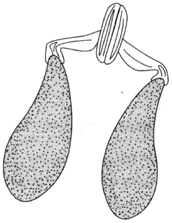Evolutionary Modifications in Flowers
Flowering plants made a “sudden” appearance during the late Mesozoic era, approximately one hundred million years ago, and then rapidly increased during the Eocene period. Primitive flowers had numerous and separate parts and a superior ovary. Magnolias and the tulip tree, Liriodendron, exhibit these characteristics and are thus recognized as primitive plants. In time, numerous modifications in flower parts took place. Flowers lacking the perianth depend on wind for transferring pollen. Flowers of the poplar tree are of this sort. When present, perianth parts may be free (that is, not united), as in primitive flowers, or they may be partly or wholly united in the calyx, corolla, or both. The morning glory is an example.Many flowers have evolved mechanisms that invite visitations from animals, insects, birds, and mammals that play roles in the transferring of pollen from one flower to another and from one plant to another (pollination). The production of nectar, a sugary liquid, is one such mechanism. While the flowers of many species are self-compatible, the pollen of one flower being able to fertilize the ovules of the same flower, the flowers of many other species are self-incompatible, the fertilization of ovules in one flower being dependent on pollen being transferred from another flower. Self-incompatibility among flowering plants is of two kinds. One is anatomical, wherein differences of structure do not allow the pollen grains to be transferred to the stigma of the same flower. The other is
 |
| Figure 35-11 Pollinia. |
chemical, wherein pollen is unable to grow on the stigma of the same flower, and pollen grains from another flower are needed for fertilization. Bees, as pollen transferrers, play an important role in the perpetuation of flowering plants. Plants and animals undoubtedly evolved together.
Milkweed flowers have developed pollen grains embedded in a waxy material called pollinia (figure 35-11). The grains become entangled in the feet of visiting insects, which later carry the grains to neighboring flowers. Pollen becomes stuck to the bodies of bees when they are seeking nectar and, in this manner, is carried to neighboring flowers. Interestingly, however, some insects have bypassed this system of what might be called “intended purpose” by drilling holes at the base of the corolla to search for nectar, thus avoiding contact with the pollen.
The significance of photoperiod in inducing flower initials is discussed in chapter 19 on hormones.




